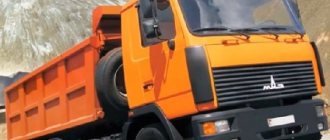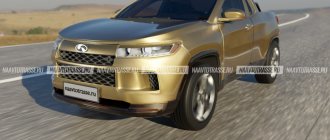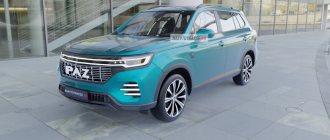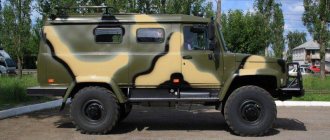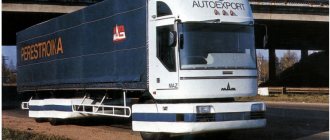Author: arek14
22 July 2022 19:27
Tags: MAZ cars Belarus vehicles
17125
25
Trucks from Belarus are known far abroad. BelAZ and MAZ vehicles are easily recognizable at first sight. And if the former are often huge mining dump trucks, then cars from the Minsk Automobile Plant can be seen in any locality. But few people know that MAZ also produces completely different equipment. Multi-ton machines are called “centipedes”, and they are used for a variety of purposes. Read more about the giants from Minsk later in the review.
1.
0
See all photos in the gallery
2.
MAZ-528/538
0
By decision of the Soviet government in 1954, a new enterprise was opened in Belarus. Over time, the Minsk Wheel Tractor Plant (MZKT) became part of MAZ, where multi-ton multi-wheeled trucks were designed and produced. The first development of engineers from a secret special design bureau was the MAZ-528 wheeled tractor. Then the project was improved and the modernized MAZ-538 model went into production. A multi-purpose tractor weighing 17.6 tons could move through wetlands and on surfaces with large slopes. It was equipped with various attachments with which you can dig trenches, loosen and move soil, fell trees, and uproot stumps.
×
3.
0
In 1956, a prototype of the MAZ-529 two-wheeled truck was presented. This machine is a single drive axle with an engine, transmission and cab. The frame with the body and attachments is a variable element.
4.
Four-axle 8x4 trucks occupy an intermediate position between the classic most popular road construction trucks with a 6x4 wheel arrangement and the high-performance, but expensive and rare
Five Legs .
Four-axle trucks are a fairly popular market segment, and almost every truck manufacturer is trying to stake out a place in it. MAZ also settled in this market niche.
01.
Today, MAZs with an 8x4 wheel arrangement are already a common occurrence, and they are taken for granted. But this was not always the case. MAZ's four-axle model took a long time and with difficulty to make its way onto the conveyor belt. Let's remember how it was.
First, a little background.
Remark M-Park
02.
MAZ vehicles with an 8x4 wheel arrangement were conceived back in the mid-1960s. Even then, four-axle aircraft were included in the promising type of the 500th family. Here is a fragment of this type. However, the Soviet economic planning system imposed a lot of restrictions, and the four-axle “500th” was not destined to be born.
03.
A MAZ-500 with an 8x4 wheel arrangement might look something like this.
But this car has nothing to do with MAZ. This is an experimental NAMI-0145
, built on units of the Ural Automobile Plant in 1970.
To be fair, it should be noted that not a single Soviet automobile plant, while the USSR existed, ever mastered the serial production of civilian four-axle construction trucks. However, after the collapse of the country, the market gave car factories a choice. It would seem “Come on MAZ, go ahead!”, but MAZ was in no hurry at all...
04.
The first to find its bearings was the Minsk Wheel Tractor Plant, which had separated from MAZ.
Already in 1994, an experienced four-axle vehicle MZKT-6515
. Its serial production started in 1995. The model, having gone through several modernizations and tried on several body styles, was present in the program for almost two decades.
05.
In 1996, KAMAZ presented its four-axle truck.
By attaching the fourth axle to the 15-ton KAMAZ-65115,
Chelny made a dump truck with a lifting capacity of 18.5 tons and received an additional chassis option for special superstructures.
This vehicle was called KAMAZ-6540
.
Photo by
Sergei ANDREEV 06.
But against the Kamaz 18.5-ton truck, MAZ could easily put up its 20-ton three-axle truck
MAZ-5516
.
And KAMAZ makes a direct competitor for the MAZ three-axle hit and... very quickly builds a four-axle version based on the new 6520 family. The new 25-ton four-axle KAMAZ-65201
has already been on sale since 2000.
With this model, KAMAZ even managed to penetrate the purely domestic Belarusian MAZ market. For example, this KAMAZ-65201
worked in Grodno.
07.
Then the competition is only growing.
Since November 2004, the Kremenchug Automobile Plant has been mass-producing its new four-axle trucks KrAZ-7133S4
.
08.
In 2004, the new domestic truck manufacturer
Yarovit
built prototypes of its four-axle dump trucks in Minsk. In 2005, their small-scale, but still serial assembly will begin in St. Petersburg. MAZ still “doesn’t itch”...
09.
At the STT'2006 exhibition, a car showed its 25-ton four-axle dump truck.
This truck, which received the index Ural-6563
, roughly speaking, was the heir to the ideas embedded in the prototype
NAMI-0145
.
Thus, by 2006, all (!) domestic automobile factories already had a four-axle national economic chassis in their program. Everything except MAZ...
10.
And finally, in 2007, a miracle happens. MAZ has finally been honored to make its own four-axle vehicle. The last of all CIS car factories. So why did it take so long? But by that time, the Europeans and the Chinese had already firmly established themselves in the segment.
11.
Under the cab,
the MAZ-6516A8-321
had an 8-cylinder V-shaped engine
YaMZ-6581.10
with a power of 400 hp, coupled with an
MFZ-430
and a 12-speed Chinese gearbox
Shaanxi 12JS200TA
. The dump truck's load capacity was 25 tons with a total weight of 41 tons.
12.
It was difficult to fit the new model into MAZ’s technological assembly cycle, so four-axle vehicles were assembled only a little, and then “outsourced” altogether. Since the summer of 2009, the JV MAZ-MAN JSC has been engaged in the assembly of MAZ 8x4 vehicles.
Photo
by Konstantin ZAKURDAEV 13.
However, the market received this car very well. For example, this example built Olympic facilities in Sochi.
14.
And this one, registered all the way in Vladivostok, worked in Moscow.
15.
This
MAZ-6516A8
has become comfortable in Turkmenistan.
16.
In 2010, the four-axle family of MAZ trucks was given a new impetus by modernizing them. We redistributed the load on the axles, increasing the distance between the front axles from 1600 to 2030 mm, and began to “try on” new engines and bodies.
17.
The first sign of the modernized family was
the MAZ-6516V8-520
with a U-shaped platform and a 400-horsepower
MAN D2066 LF41
Euro-5 engine. By the way, this was the first Belarusian dump truck that was raised to Euro-fifth standards.
Photo
by Maxim SHELEPENKOV 18.
Then her appearance began to slowly change. First, they installed a restyled front mask, but with the “old” bumper.
19.
The four-axle vehicle appeared with a completely new appearance in 2011.
This is an exhibition version under the symbol MAZ-6516W8-420-000
and with a 400-horsepower
Cummins ISLe 400 40 diesel
.
20.
On production cars, bumpers painted in the color of the cab are almost never found.
Although from a practicality point of view, this is perhaps even better. This is a modification of MAZ-6516V9-480-000
.
Outwardly it looks almost the same, but the engine is different - YaMZ-651.10
.
21.
Last year, the family was replenished with a new modification
MAZ-6516B9-481-000
with a body of “slightly” increased capacity. MAZ, having succumbed to the trend set by the Chinese and KAMAZ, is now very interested in dump truck bodies of monstrous volumes. This version of the “dumper’s temptation” is another manifestation of, in our opinion, to put it mildly, an unhealthy hobby that provokes overload with all that it entails.
What about special equipment on MAZ four-axle chassis? It exists, but, surprisingly, for some reason there is still very little of it.
22.
The first special vehicle was presented in 2010.
KS-6571BY
truck crane with a fashionable ovoid boom with a lifting capacity of 40 tons was built at Mogilevtransmash, a branch of MAZ. However, apparently, the car did not go into production.
Photo by
Andrey FILIPOV 23.
The second option was the South Korean concrete pump
Everdigm 43CX-5
, which Mogilevtransmash mounted on a long-wheelbase
MAZ-6516
.
This special version was given its own index MAZ-693269
, but this car also remained a single copy. However, MAZ did develop cooperation with the Everdigm company for some period.
Photo by
Sergei LIPSKY Firefighters' four-axle MAZs, albeit in small quantities, still saw the series, with two options for special superstructures, the supplier of which was Everdigm.
24.
The Everdigm EAP481004
articulated lift was installed at the same Mogilevtransmash on an extended
MAZ-6516
, and several of these machines, already under the designation
AKP-48,
entered the Belarusian Ministry of Emergency Situations.
Photo by
Sergei LIPSKY 25.
The second firefighting four-axle MAZ is a ladder truck.
Again, South Korean, Everdigm ERL52
, mounted there, in Mogilev.
Domestic index - AL-52
. This example is serving in Grodno.
26.
There is another very exotic MAZ four-axle vehicle - this is a
Jenz HEM 561DQ
grinding unit MAZ-6516B9 , paired with a Mozyr
M75-05
.
This special vehicle was again assembled in the MAZ “body shop” - “Mogilevtransmash”, therefore the car has its own industry index - MAZ-694469
. This unit operates in the Vileyka forestry enterprise.
Photo by
Sergei LIPSKY 27.
But the main specialization of MAZ four-axle trucks is still dump trucks.
29.
UPD 02/08/2016
.
In 2016, the evolution of MAZ four-axle vehicles entered a new stage. A four-axle dump truck meeting the Euro-6 environmental standard was presented. Its index is MAZ-6516M9-620
. A detailed story about him is here.
It is strange that there is not a single concrete mixer or ditch tow truck mounted on a MAZ chassis with an 8x4 wheel arrangement. However, it is gratifying that four-axle MAZs, although not quickly, still saw the light of day. But there are still fewer of them than there could be. Maybe it’s time to think about stepping up work with third-party “bodybuilders”?
MAZ-535/537
0
At the same time, the 1950s, the first four-axle truck was created at SKB-1. The MAZ-535 all-wheel drive vehicle was designed as an artillery tractor, and then it was adapted to transport missiles.
6.
0
7.
0
The design of the MAZ-535 contains many technical innovations that were not previously used in the automotive industry of the USSR: a semi-automatic gearbox, a hydromechanical transmission, a wheel inflation system, and a trough-type frame. In the design of the car, engineers included very high cross-country ability and reliability. The MAZ-535 had half a meter ground clearance and could overcome fords up to 1.3 meters deep and drive along a road with a 30-degree slope.
8.
0
The MAZ-535 tractor was produced from 1958 to 1964. first in Minsk and then in Kurgan. The model received many military modifications and was produced under different names. Due to the headlight in the center of the front part and the characteristic appearance, the MAZ-535 was nicknamed “Cyclops”.
9.
0
10.
0
From 1959 to 1989, the MAZ-537 was in production, which is a modernized version in the back of a truck tractor. The vehicle is still actively used to transport tanks, tracked armored vehicles and artillery mounts.
11.
Belarusian heroes: MAZ army heavy trucks
60 years ago, just in time for the anniversary of the revolution, a car appeared in the bowels of the Minsk Automobile Plant, which laid the foundation for a whole family of heavy “heroes”, and subsequently a separate brand with the same name. The main purpose of these vehicles was and remains military.
Anton Mikhailov
As you guessed, we are talking about the MZKT brand, better known under the trade name “Volat” (“hero” in Belarusian). Its history begins with a special design bureau created at MAZ. The Minsk Automobile Plant began with the production of two-axle MAZ-200 vehicles developed at YAZ and was not distinguished by a special design school. However, it was there that, by decision of the Soviet government, SKB-1 was created, the main focus of which was the design of heavy wheeled military equipment. Its success was largely determined by the personality of the leader - he was the talented engineer Boris Lvovich Shaposhnik, who had previously worked as the chief designer at AMO/ZiS and UAZ.
FIRST BORN
The first-born of SKB, however, was not a truck, but a MAZ-528 (4x4) tractor, which later turned into a single-axle MAZ-529. With its own weight of 9 tons, it could tow a 25-ton trailer. Of course, the military immediately began to use it.
The very first product of SKB-1 was the experimental tractor-pusher MAZ-528
In 1956, a prototype of the heavy four-axle tractor MAZ-535 appeared, which laid the foundation for all subsequent trucks. At that time it was an unheard of advanced machine. Much was used for the first time in domestic practice: hydromechanical transmission, semi-automatic gear shifting without interruption of power flow, original frame design with Z-shaped side members, torsion bar suspension, differential power drive system, power steering.
The nine-meter long vehicle with a total weight of 31.5 tons was equipped with a D12 tank diesel engine with a power of 375 hp. s., installed behind the four-seater cabin. The technical requirements drawn up by the military were very high: ground clearance - 500 mm, fording depth - up to 1.3 m, climbability - up to 30 degrees, ambient temperature from −50 to +50 ° C.
The MAZ-535 stood out with a third headlight - it was infrared illumination for the operation of a night vision device
After extensive testing, the MAZ-535A (ballast tractor) and MAZ-535V (truck tractor) went into production and were widely used by the military. For the first time, civilians were able to see these products at military parades in Moscow.
In connection with the advent of a more powerful D12-525 engine, the car was improved, and soon a strengthened version of the MAZ-537 appeared. It was unified in many respects with its predecessor, but had greater engine power (525 hp) and, therefore, a reinforced frame and braking system.
The heavy wheeled evacuation tractor (KET-T) on the MAZ-537 chassis of late production still serves in the army
The vehicles were produced in Minsk until 1964, when their production was transferred to the Kurgan Wheel Tractor Plant (KZKT), where their production continued until 1989 (!). In the army, these vehicles were equipped with dozens of superstructures depending on their purpose; in addition, they were supplied to the national economy in small quantities for transporting particularly heavy loads. It should be noted that these vehicles came with a 10-year warranty - unheard of for trucks of that era.
"HURRICANE"
The next epoch-making machine owes its appearance to the rocket scientists who in 1960 created the first guided solid-fuel operational-tactical missile "Temp". Especially for it, SKB-1 quickly developed a carrier chassis, since the advantage of a wheeled chassis over a tracked one was proven. And the famous MAZ-543 was born, which received the unofficial nickname “Hurricane”.
It was an evolutionary successor to the previous series - the fundamental design and a number of units were preserved. But its technical characteristics - speed, dynamics, maneuverability - were higher than those of its predecessor.
The most famous MAZ-543, carrier of the R-17 missile, known in the world as Scud-B
The updated D12A-525 engine now had a direct injection system, a dual starting system, and a pre-heater. Fuel consumption was 39 liters per 100 km, power remained the same - 525 hp. With.
The hydromechanical drive consisted of an automated four-speed planetary gearbox and a single-stage torque converter, transmitting torque to all eight wheels.
But the main feature that gave the car such a recognizable appearance was the unique layout of the cabin, or rather, cabins. With the classic layout, the missile launcher located at the rear noticeably increased the height and center of mass of the vehicle. In this regard, the designers used an ingenious solution - to use two cabins with free space between them. They were made from heavy-duty fiberglass with polyester resin (this was in 1962!). The sound insulation is also impressive - the noise in the cabin did not exceed 85 dB; a good indicator even for modern trucks.
Its descendant under the symbol MAZ-7313 in the role of towing indivisible cargo for the national economy
The total weight was 39 tons, ground clearance 440 mm. With dimensions of 11.5x3x2.9 m, the MAZ-543 had a maximum speed of 60 km/h.
The Hurricane series consisted of three generations and an endless number of modifications, both military and civilian. This is the original MAZ 543 (g/c 19.1 t), MAZ 543A (g/c 19.4–22.2 t), MAZ 543M (g/c 22.2 t, without right cab), MAZ 543P and many other. More than six dozen military superstructures were mounted on these chassis, including the Scud tactical missile, the S-300 anti-aircraft missile system, the Smerch multiple launch rocket system, the Bereg artillery complex and the Rubezh anti-ship missile system. The family is currently produced to order.
MULTIPEDS
In subsequent years, the special bureau continued to develop special chassis that had no analogues in the world, which received the general name of mobile ground-based missile systems. The first was the five-axle MAZ-547 conveyor, which in the process became the six-axle MAZ-547A. Many new components were developed for the MAZ-547; it received a more powerful engine (680–710 hp), a reinforced hydraulic transmission and a chassis with air-hydraulic suspension on wishbones with hydraulic balancers. The increased axle load reached 15 tons.
The 547 family was an enlarged 6-axle version of the Hurricanes.
But, since the type of missiles based on these chassis was destroyed under the SALT-2 treaty, their production was stopped, and attempts to adapt them for civilian needs were unsuccessful. But these vehicles formed the basis of the following families that are still used by the Russian army to this day.
The most secret prototype of military vehicles, MAZ-7904, existed in a single copy
When developing the first seven-axle chassis MAZ7912 for the Topol missile, it was necessary to solve problems previously unknown even in theory. In the early 1980s, a modified MAZ-7917 chassis (14x12) appeared for the same purposes. It was equipped with a V-58-7 (V12) diesel engine with a power of 710 hp. With. In 1995, a modern eight-axle transporter of ballistic missiles "Topol-M" MZKT-79221 appeared, unified with its predecessors.
The curb weight of the vehicle is 44 tons, the load capacity is 80 tons, the power of the YaMZ-847 engine is 800 hp. s., maximum speed 45 km/h, range 400 km.
The record of the world's most multi-axle chassis MAZ-7907 has not yet been repeated by anyone
Finally, we should remember two cars that stood apart and did not go into production. However, they became a kind of record in the creation of multi-axle oversized chassis, unsurpassed anywhere in the world.
15T316 - technical closure column support unit
The first of them, MAZ-7904, was manufactured in the strictest secrecy in 1982. Its purpose is still classified; it is only known that it was sent to Baikonur for testing. All its characteristics are striking: length - 32.2 m, width - 6.8 m, total weight - 360 tons.
Two other twelve-axle all-wheel drive (!) MAZ-7907 chassis were manufactured in 1985 to transport the then-designed 100-ton “Molodets” rocket. They had a unique design: a gas turbine engine with a power of 1250 hp. With. aggregated with an alternating current generator. 24 individual air-oil-cooled synchronous AC motors drove each of the wheels. However, the ensuing peaceful detente led to the fact that the machines were never used for their intended purpose.
The latest generation of missile carriers, MZKT-79221, is currently on combat watch.
The topic of military and civilian heroes does not end here, and we will definitely return to it.
The editors recommend:
Why do piston rings stick and how to prevent it?
A traffic police officer searched my car: did he have the right to do so?
Russians may be left without foreign cars: Western automakers have stopped supplying cars to our country
A ship that was transporting cars to Russia was detained in France
Half of the car factories in Russia have closed
Discussion Cancel
MAZ-543/7310
0
With the advent of new ballistic missiles in the USSR, the idea arose to install them on a heavy-duty chassis. The all-wheel drive four-axle MAZ-543 began mass production in 1962. And three years later, the car was spotted on Red Square in Moscow, when Western journalists saw the 9K72 Elbrus missile system at its base. Also, the MAZ-543 and its subsequent modifications were used in the 9K76 Temp-S missile systems, 9K58 Smerch multiple launch rocket systems, and S-300 anti-aircraft missile systems.
12.
0
13.
0
Also, these 11.6-meter-long vehicles were used as fire engines, dump trucks, and for transporting heavy bulky cargo. Cars weighing 23 tons could carry up to 20 tons of cargo or pull a trailer of 25 tons. The maximum speed of the car is 60 km/h, which was achieved thanks to a 525-horsepower V12 engine with a volume of 38.8 liters.
14.
0
15.
How to use Photomath?
Photomath is a smart calculator that recognizes handwritten formulas and equations through the camera and provides instant solutions.
The application is very simple to use and allows you to carry out calculations in the mode of a standard calculator , as well as in the mode of recognizing equations from the camera . By pointing your lens at a formula (either handwritten or printed in a textbook), you will get a step-by-step solution and the final result.
The application allows you to process various operations:
- problems with roots and fractions;
- arithmetic operations;
- linear equations and logarithms (not all);
- integrals, trigonometric functions, etc.
To date, Photomath cannot handle some functions and operations, but the developers are constantly working to improve the program and introduce new methods for processing tasks.
This application will be a good assistant and cheat sheet for schoolchildren and students. The program will also be useful for parents who can quickly check their child’s homework.
MAZ-547/7916
0
The increase in the size of missiles and their flight range forced the development of increasingly heavy-duty chassis for their transportation and launch. The 6-axle MAZ-547 was designed for the 15P642 Temp-2S and 15P645 Pioneer missile systems and was mass-produced from 1970 to 1984. The car had 6 axles, of which 5 or 6 were driven, depending on the modification.
16.
0
17.
0
The car received a turbocharged V12 diesel engine with a volume of 25.9 liters and a power of 650 hp, an automatic transmission, hydropneumatic suspension, and tires with adjustable pressure. Thanks to this, a vehicle with a length of 16.8 meters, a width of 3.2 meters and a weight of 27.5 tons can move in severe off-road conditions. Maximum load capacity is 62 tons, possible highway speed is up to 40 km/h. The fuel consumption of the MAZ-547 is 260 liters per 100 kilometers.
18.
0
The MAZ-547 crew consists of 2 people. In the left cabin there is a driver, in the right - the commander of the missile system crew.
19.
Cargoautoinfo. Freight transport in detail.
The snow whirlwinds raised by cars at the new MAZ training ground and caught in the camera’s lens look strange. But it just so happened that the show of new equipment from the Minsk Automobile Plant took place in the last days of winter. In another situation, the story about it could have been postponed until next winter, but too much turned out to be connected with this show. Cars are the boss of everything
Last year, the plant began active preparations for work on creating a fundamentally new cabin for MAZ vehicles. It was installed on samples of some models of new equipment, which were demonstrated at exhibitions of the Minsk Automobile Plant at the end of 2010. Serial production of the new cabins began in February of this year, so the display of updated cars at the factory site can be considered a full-fledged premiere.
A large cabin with a high roof - the most comfortable option for international and intercity transportation - is intended primarily for installation on the 5440 truck tractor and 5430 and 5340 flatbed vehicles in various modifications. The cabin is equipped with two berths with a width of 700 mm. At the customer's request, it can be equipped with air conditioning and an independent air heater to maintain the temperature when the engine is turned off.
Truck tractor MAZ-5440E9 Euro 5
Flatbed long-haul truck MAZ-6410
Flatbed long-haul truck MAZ-5340 Euro 5
An interesting solution was used in the development and production of doors. Now they are combined, glued: approximately 3/4 of the door (upper part) is steel, the bottom is plastic. This ensures high corrosion resistance of the doors. In terms of technical and design solutions, the cabins of MAZ trucks of the new family are close to the best world analogues.
Dump truck MAZ-6516 Euro 4
For the new MAZ-5550 dump truck, a “police turn” is not a problem.
Dump truck MAZ-6501 Euro 4
For the same cars, simpler cabs of lower height are produced, and for cars of the 5550 and 65011 families - so-called “day” cabs. The main advantage of the cabins is the use of a new instrument panel and a reorganized driver's workplace. When updating the cabin interior, new modern technologies for manufacturing interior parts (upholstery, instrument panel, seats, etc.) are used.
Work is underway to improve the corrosion resistance of MAZ cabs. For this purpose, a new sidewall design is being developed. To improve reliability, a new front suspension design will be introduced. Based on this cab, MAZ developed for the first time a two-row tandem cab for special vehicles.
Area for fine-tuning new cabins.
In the near future, the production capacity of frames of the 6430 family will allow the production of up to 70-80 cabins per day. Along with measures that increase the quality and improve the image of the Minsk Automobile Plant, such as increasing the production of cars of a new family, introducing painting with two-component enamels of the cab frame, areas are being prepared for the organization of a site for cataphoresis priming of cab frames, painting and drying chambers are being installed for restyling parts and car cabs in the painting and metal coating shop.
MAZ chief designer for trucks Alexander Zakharik; Head of Corporate Communications Department Vladimir Spiridonov; MAZ chief designer for buses Alexander Myshko.
Introducing MAZ's new products, Chief Designer of trucks Alexander Zakharik noted that one of the plant's priorities is to enter serial production of vehicles that meet the requirements of Euro 4 and Euro 5 standards. Already in the second quarter of 2011, the production of vehicles meeting Euro 4 standards should exceed 60 % of total production. The main power unit for this will be the new engine of the YaMZ-651 family.
From the end of this year, another new engine from Yaroslavl will begin to arrive on the conveyor - YaMZ-536, the equipment with which in Minsk vehicles in 2010 will exceed 70% in its segment. At the same time, he noted that MAZ has certain disagreements with the Power Units division of the GAZ Group, but the remaining time is enough to eliminate them. First of all, we are talking about the problems of the cost of Yaroslavl engines, but, as Vladimir Spiridonov, Head of the Corporate Communications Department of Power Units, noted, there is every reason to achieve a mutually acceptable solution.
Speaking about the promising areas of work of the Office of the Chief Designer, Alexander Zakharik said that work on the hooded version of a heavy-duty vehicle is in full swing at the plant. Minsk residents plan to show off the new product at the September “Comtrans” in Moscow. At the same time, a completely new cabin is being prepared, the premiere of which is scheduled for 2015.
Buses are also MAZ
The bus production of the Minsk Automobile Plant is relatively young - it is just over 15 years old. But during this time, many interesting models were produced here - just remember the MAZ-171 apron bus, or the MAZ-205 urban low-floor articulated bus. Russian carriers have long been operating city and intercity buses originating from Minsk.
Large class bus MAZ-231
Middle class bus MAZ-241
At the February show, worthy successors to the traditions of the highly professional design school and MAZ designers were presented - the low-floor large-class commuter and intercity bus MAZ-231 and the new small-class MAZ-241. The first car is already quite well known - it received a “Promotion” diploma at the last MAF in August 2010.
Overall, the bus was a success, although several questions still remain about its readiness for release. For example, what to do with the strange niches above the doors into which the door pulls are retracted? The bus shouldn't be released like this. Well, at least the plastic can be cut and laid more evenly!
Such niches in the MAZ 231 are gates for dirt and dust, which will ultimately end up in the cabin.
The MAZ-241 has already been described in detail in the previous issue of GRUZAVTOINFO, but let us briefly recall its characteristics. Navistar Acteon 4.12TCE 4,745 cc inline four-cylinder turbodiesel engine. and a power of 185 hp/2200 min-1 with a torque of 700 Nm/1200-1600 min-1. The bus is designed to carry 36 passengers with 22 seats. It is impossible not to say a few words about the design of the new bus.
The workplace of the driver of the MAZ-241 bus is made with dignity.
A first-class school of stylists has long been established at MAZ. But it's one thing to develop the style of a large bus, and quite another to show off the mastery of a car that's less than 7m long! The design of the 241 is simply impeccable. The interior layout with the engine located in it can rightfully be called the best in its class. Laconically designed headlight system, convenient entry, very functional and comfortable seats. In a word, the new product was clearly a success. Russian transport workers, alas, not spoiled by compact buses of modern world class and quality, will clearly like it.
As Chief Bus Designer Alexander Myshko said, his team is faced with the task of expanding the model range of buses bearing the MAZ brand in the next couple of years.
What's in the future
Against the backdrop of such interesting prospects for the development of MAZ in traditional sectors of the automotive industry, the possibility of a light-duty truck and minibus appearing in its product range seems somewhat strange. But here the main role is played not by economics, but by politics. A huge army of Belarusian businessmen earn their living by private transportation, including small consignments, such is the specificity of cross-border trade and transit. They are carried out, basically, either on the old European “second-hand”, or on our “GAZelles”. But the days of worn-out “old stuff” are irrevocably gone, and dependence on the “big brother” auto industry is not very welcomed by official Minsk. So the decision was made to develop our own small-scale production. The model was based on the Toyota Hiace H100 minibus from thirty years ago (!), skillfully “reincarnated” by one of the Chinese automotive “cooperatives”, from which they made a truck with a gross weight of 3 to 5 tons. The only reassuring thing about the fate of this epoch-making project is that this is already the third attempt to start such production, of which the first two have long been forgotten, although they were based on much more modern models of European production.
God willing, the same fate will befall this automobile revolution. Otherwise, the assembly line will produce a model whose age will approach the forty-year mark. However, in order to produce it, it is necessary to build an almost new plant, and this requires considerable funds.
If we talk about more realistic prospects, they consist in bringing the production of trucks, vehicle kits, bus and trolleybus chassis and buses to 32.0 - 35.0 thousand units in 2011 - 2012. At the same time, equipment exports to Russia should reach almost 70%, and outside the CIS – almost 10%. Russia traditionally occupies the main place in MAZ's export supplies, and a lot of work is being done here by representing Minsk equipment in Russia. It was she who organized the press tour, celebrating the 15th anniversary of this productive Russian-Belarusian union.
Quite active work is currently underway to create a legal, financial and economic basis for creating an automobile manufacturing alliance based on the joint work of KAMAZ and MAZ. The project is certainly interesting and promising, especially given the access of both partners to modern foreign technologies, however, it is too early to say how it will develop. Wait and see.
MAZ-7904
0
In 1984, Minsk engineers developed an experimental MAZ-7904 chassis. It was supposed to be used to transport and launch intercontinental ballistic missiles. During the Cold War, the product was kicked out of the hangar only at a time when satellites of a potential enemy were not flying overhead. For a long time the car was considered lost in the vicinity of Baikonur, but recently it was discovered again in one of the hangars.
20.
0
The carrying capacity of the MAZ-7904 is more than 200 tons. The vehicle is propelled by a 1,500 hp marine engine. and a diesel engine of 330 hp. The length of the car is 32.2 meters, width - 6.8 m. The diameter of each Bridgestone wheel is 2.8 m. The maximum speed of the monster is 27 km/h.
21.
